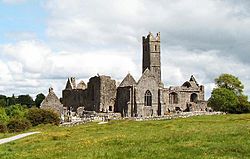Quin Abbey facts for kids
| Mainistir Chuinche | |

Quin Abbey
|
|
| Monastery information | |
|---|---|
| Other names | Quin Friary |
| Order | Franciscans |
| Established | c. 1350 (church), 1433 (abbey) |
| Disestablished | 1541 |
| People | |
| Founder(s) | MacNamara family |
| Architecture | |
| Heritage designation | National Monument |
| Style | Gothic |
| Groundbreaking | 1402 |
| Completion date | 1433 |
| Site | |
| Location | Quin, County Clare, Ireland |
| Coordinates | 52°49′9.43″N 8°51′46.87″W / 52.8192861°N 8.8630194°W |
| Public access | Yes |
| Official name | Quin Abbey |
| Reference no. | 15 |
Quin Abbey (in Irish, Mainistir Chuinche) is an old, ruined abbey in Quin, County Clare, Ireland. It was once home to Franciscan friars, who are like monks. This special place has a long and interesting history.
Contents
History of Quin Abbey
The name Quinche comes from an old Irish word. It might mean a type of tree, like a strawberry tree or a quince tree. People used quince fruit to make jam a long time ago.
From Monastery to Castle to Church
A very old monastery stood here before, but it burned down in 1278. After that, a Norman castle was built by a military leader named Thomas de Clare. You can still see the huge foundations of the castle's corner towers today.
Around 1350, the castle was already a ruin. The MacNamara clan then rebuilt it into a church. This shows how the site changed over many years.
Rebuilding the Friary
The abbey you see today was rebuilt between 1402 and 1433. It was either Mac Cam Dall Macnamara or Sioda Cam MacConmara who led this work. They used part of the old castle's wall to build the new structure. This building was actually a friary, which is a type of monastery for friars.
In 1541, during a time called the Reformation, King Henry VIII took control of the friary. It then went to Conor O'Brian, who was the Earl of Thomond.
Times of Change and Restoration
Around 1590, the MacNamaras got the site back. They started to repair and restore the monastery again. By 1604, it was fixed up and ready.
About 1640, the building became a college. Some stories say it had as many as 800 students! However, only ten years later, Oliver Cromwell arrived. His soldiers attacked the friary, killing the friars and destroying the building.
In 1671, the building was restored once more. But it never became as important as it had been before.
A Well-Preserved Ruin
In 1740, a visitor named Bishop Pococke described Quin Abbey. He said it was "one of the finest and most entire monasteries" he had seen in Ireland. Even in 1808, the monastery was still in very good condition, much like Pococke had found it.
The friars were finally asked to leave in 1760. However, the last friar, John Hogan, stayed there until he passed away in 1820. By then, the buildings had become ruined because no one was taking care of them.
Architecture and Visiting Quin Abbey
Even though most of the roof is gone, the main structure of Quin Abbey is still in good shape. It has a complete cloister, which is a covered walkway around a courtyard. Many other old parts of the building are still there, making it a very important historical site.
There is a visitor centre nearby, and you can explore the abbey and its grounds for free. A caretaker is always there to look after the monument. Lights have also been put in place to light up the abbey at night. The graveyard around the friary is still used today.
See also
- List of abbeys and priories in Ireland (County Clare)



